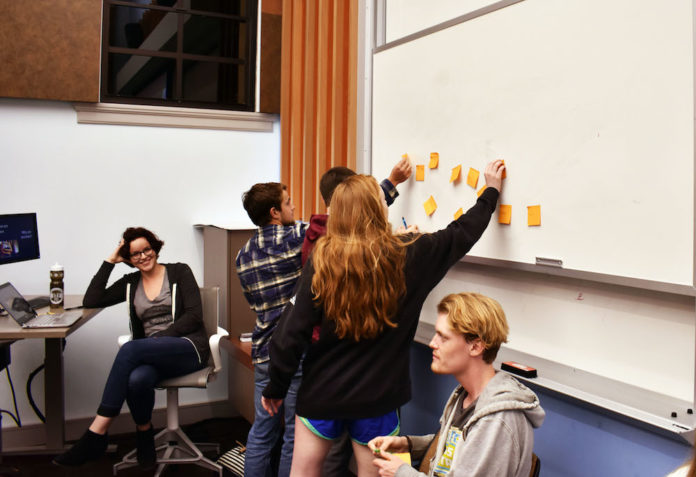
Active Minds, a student mental health advocacy group on campus, teamed up with the Student Athlete Advisory Committee (SAAC) to host a workshop focused on eating disorders and body image among athletes Feb 18. According to Active Minds co-President Adelia Nunn (senior), the idea for the collaborative workshop emerged when Thomas Robertson (senior), a member of the Occidental men’s track and field team, reached out to Active Minds Fall 2019 about the possibility of developing programming around these issues to the Occidental student athlete community.
Softball player Elizabeth Pang (junior) and soccer player David Paine (junior) serve on SAAC’s health and wellness sub-committee, which teamed with Active Minds to organize the event and compile resources for those in need. According to Paine, SAAC entered the 2019–20 school year hoping to make a bigger impact on campus.
“Obviously, [the health and wellness committee] is not going to be able to change the culture [or] people overnight or even in a year. But we definitely want to promote awareness and just increase conversations,” Paine said. “I think one of the biggest things that we’re hoping — and I think that we’re seeing — is changing perceptions around certain things like mental health, eating disorders, body positivity and just really bringing them to the forefront.”
According to Nunn, the event began with an anonymized share-out about participants’ past struggles with body image. Program coordinators then presented about the risks of student athletes developing image and eating disorders, before moving into an exercise meant to challenge popular perceptions about the causes and manifestations of these disorders. The program ended with a discussion of available resources and how, as teammates, athletes can look out for and help others struggling with these problems.
“[These disorders] uniquely affect athletes,” Nunn said. “They are so active, and so any sort of disordered eating is amplified by the fact that they are exercising a lot. Another thing about it is just in kind of the media world for athletics, there’s definitely a lot of pressure to look a certain way.”
The National Eating Disorders Association and the National Collegiate Athletic Association (NCAA) have long identified the increased risk of eating disorders among athletes as a result of the field’s competitive nature and unique stressors, though the NCAA has often been criticized for its approach to addressing the problem. The subject reemerged in the national spotlight after the New York Times published the testimony of Mary Cain, a former NCAA track athlete whose career collapsed after abuse and pressure from coaches pushed her toward disordered eating and detrimental training regimens.
Nunn said eating disorders do have a significant gendered aspect.
“Eating disorders are more common among women,” Nunn said. “However, men do struggle with eating disorders, and there’s a lot less support for them. People who are non-binary have unique struggles as well because they might not fit the physical mold of other people on their team.”
As a member of an all-female team, Pang said she understands the pressure of competing in front of an audience and fellow teammates can take its toll on athletes’ mental health.
“There’s a specific body type that definitely goes with each position,” Pang said. “I definitely think that it’s something that we’re always comparing ourselves to. I don’t know what it is about this environment, but when you’re with those people so much of the time, it’s easy to get swept up into that kind of mentality.”
Both Pang and Paine noted that student athletes have access to specialized resources, such as trainers, nutritionists and newly-introduced counseling sessions with staff therapist Richard Estrada, which began Jan. 31. However, Pang and Paine said disparities in athletic department funding allocation can make it difficult for athletes to access resources and foster healthy training and eating regimens.
“Coming into preseason, during the summer, we all get allocated different sponsored money,” Paine said. “Football players get more money to spend per day than any other athlete, and [our amount is] hardly enough for two meals, let alone properly feeding and fueling your bodies. So that was one of the big institutional things that we want to change.”
In terms of future advocacy, Pang said she looked forward to generating more spaces for discussion.
“The less formal spaces that we’ve made in the fall were also really good for fostering these kinds of conversations,” Pang said. “We had a queer student athlete mixer, we had a black student athlete mixer, and I think that those were really good at bringing these same kinds of issues up, just in a more comfortable setting for people.”
Paine added that he advised student athletes to utilize available resources and remind themselves that their bodies have helped them achieve their success.
“Don’t be afraid to love your body, whether that’s just to yourself or whether it’s openly,” Paine said. “I know that, as athletes, our build, who we are, that has gotten us to this level, and I don’t think we should change it.”
![]()



































